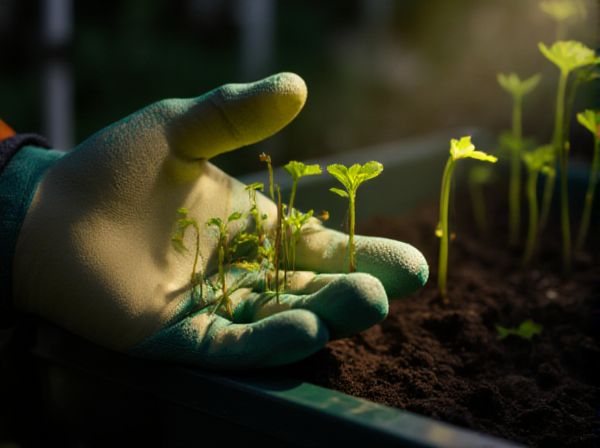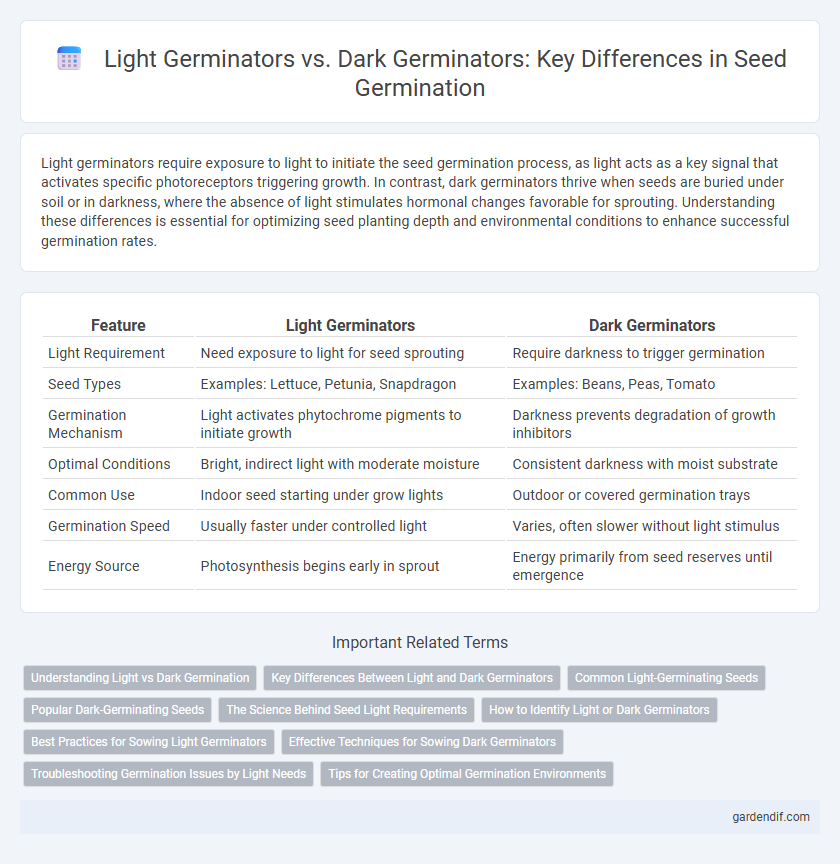
Light germinators vs Dark germinators Illustration
Light germinators require exposure to light to initiate the seed germination process, as light acts as a key signal that activates specific photoreceptors triggering growth. In contrast, dark germinators thrive when seeds are buried under soil or in darkness, where the absence of light stimulates hormonal changes favorable for sprouting. Understanding these differences is essential for optimizing seed planting depth and environmental conditions to enhance successful germination rates.
Table of Comparison
| Feature | Light Germinators | Dark Germinators |
|---|---|---|
| Light Requirement | Need exposure to light for seed sprouting | Require darkness to trigger germination |
| Seed Types | Examples: Lettuce, Petunia, Snapdragon | Examples: Beans, Peas, Tomato |
| Germination Mechanism | Light activates phytochrome pigments to initiate growth | Darkness prevents degradation of growth inhibitors |
| Optimal Conditions | Bright, indirect light with moderate moisture | Consistent darkness with moist substrate |
| Common Use | Indoor seed starting under grow lights | Outdoor or covered germination trays |
| Germination Speed | Usually faster under controlled light | Varies, often slower without light stimulus |
| Energy Source | Photosynthesis begins early in sprout | Energy primarily from seed reserves until emergence |
Understanding Light vs Dark Germination
Light germinators require exposure to specific light wavelengths, such as red or white light, to trigger seed germination, activating phytochrome receptors that regulate seed metabolism. Dark germinators, by contrast, germinate optimally in the absence of light, often relying on other environmental cues like temperature and moisture to initiate the process. Understanding these differing seed responses helps optimize agricultural practices and seedling establishment by tailoring lighting conditions to species-specific germination requirements.
Key Differences Between Light and Dark Germinators
Light germinators require exposure to light to trigger seed germination, relying on specific wavelengths to activate photoreceptors such as phytochromes, whereas dark germinators germinate optimally in the absence of light, often responding to temperature and moisture conditions instead. Light germinators typically produce small, dust-like seeds adapted to surface soil environments, while dark germinators generally have larger seeds capable of emerging from deeper soil layers. These differences influence agricultural practices, seed planting depth, and crop management strategies to optimize germination success.
Common Light-Germinating Seeds
Common light-germinating seeds include lettuce, petunia, and verbena, all of which require exposure to light to initiate the germination process. These seeds rely on specific wavelengths of light to activate phytochrome receptors, triggering enzymatic activities and hormonal changes necessary for sprouting. Proper surface sowing without covering these seeds with soil enhances their exposure to light, thereby increasing germination rates and seedling vigor.
Popular Dark-Germinating Seeds
Popular dark-germinating seeds include lettuce, spinach, and parsley, which require soil coverage to block light for successful sprouting. These seeds initiate germination in darkness due to their sensitivity to light, relying on moisture and temperature conditions instead. Understanding the specific light requirements helps optimize germination rates and ensures healthy seedling development.
The Science Behind Seed Light Requirements
Seed germination is influenced by light sensitivity, where light germinators require exposure to specific wavelengths to trigger enzymatic processes that break dormancy. Phytochromes, specialized photoreceptors in seeds, detect red and far-red light, regulating gene expression crucial for germination. Dark germinators, on the other hand, rely on factors like moisture and temperature, with light exposure often inhibiting their germination process.
How to Identify Light or Dark Germinators
Light germinators require exposure to light to trigger seed germination, which can be identified by placing seeds on the soil surface without covering them. Dark germinators need darkness to germinate, often achieved by burying seeds under a thin layer of soil to block light. Testing seed response by varying light exposure during germination trials provides a reliable method to classify seeds as light or dark germinators.
Best Practices for Sowing Light Germinators
Light germinators require exposure to light during sowing to trigger germination, making surface sowing essential for optimal growth. Using a fine seedbed and avoiding soil covering ensures seeds receive sufficient light while maintaining moisture levels. Consistent ambient temperature and humidity support seedling vigor, promoting healthy emergence in light-sensitive species.
Effective Techniques for Sowing Dark Germinators
Dark germinators require sowing techniques that ensure seeds remain covered with a thin layer of soil, maintaining darkness to trigger germination effectively. Using fine, well-draining soil and gently pressing seeds into the surface improves moisture retention without exposing them to light. Controlled environments with consistent moisture levels and temperatures around 20-25degC significantly enhance germination rates for dark germinating species.
Troubleshooting Germination Issues by Light Needs
Light germinators such as lettuce and petunias require exposure to specific light wavelengths to trigger seed sprouting, while dark germinators like beans and tomatoes need darkness for optimal germination. Troubleshooting germination issues involves adjusting light conditions by providing continuous light for photoblastic seeds or complete darkness for those inhibited by light. Monitoring seed response and ensuring the appropriate light intensity, duration, and spectrum can significantly improve germination rates and seedling vigor.
Tips for Creating Optimal Germination Environments
Light germinators, such as lettuce and petunia seeds, require exposure to specific light wavelengths, typically red light, to trigger germination, while dark germinators like tomato and carrot seeds germinate best in complete darkness. To create optimal germination environments, use transparent or translucent covers for light-sensitive seeds and ensure consistent moisture levels without waterlogging. Maintaining a stable temperature range between 20-25degC (68-77degF) and avoiding sudden light exposure for dark germinators significantly improves germination rates and seedling vigor.
Light germinators vs Dark germinators Infographic

 gardendif.com
gardendif.com